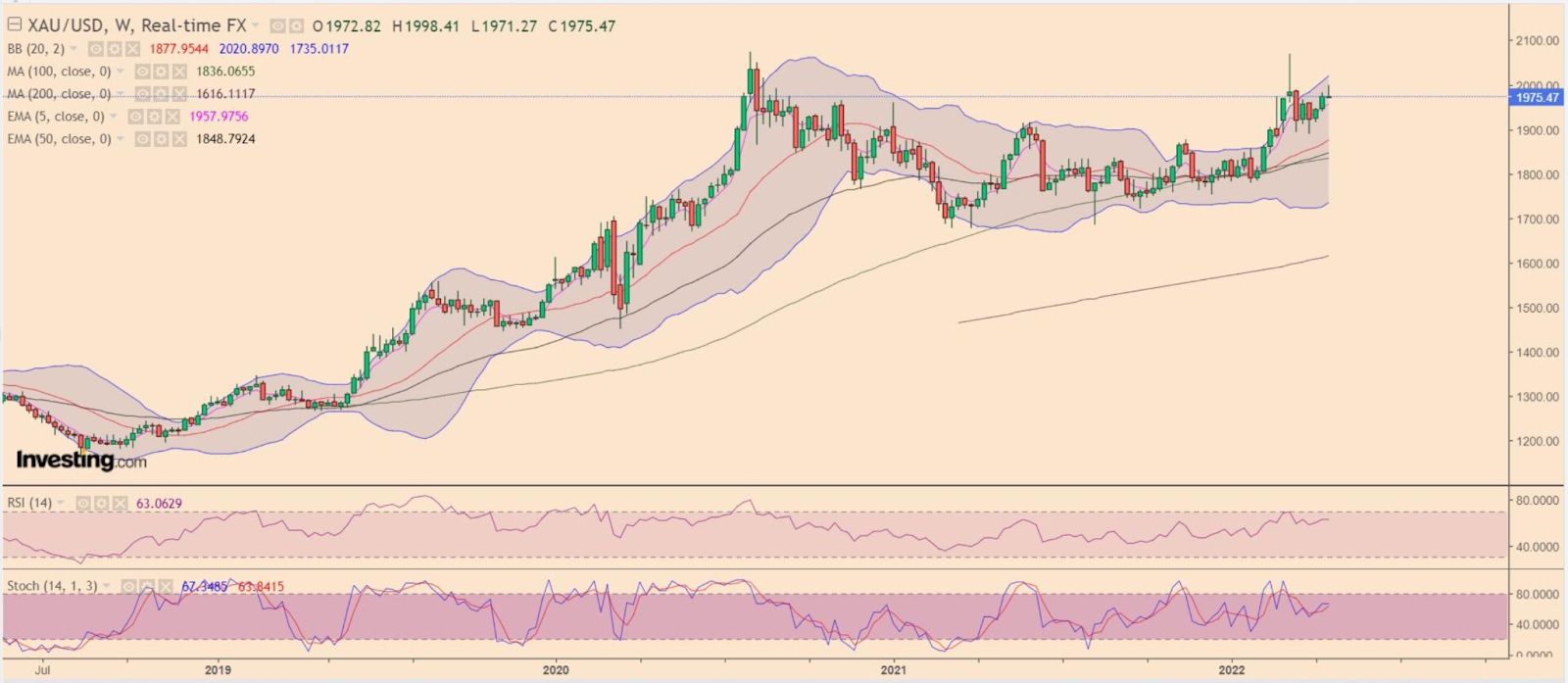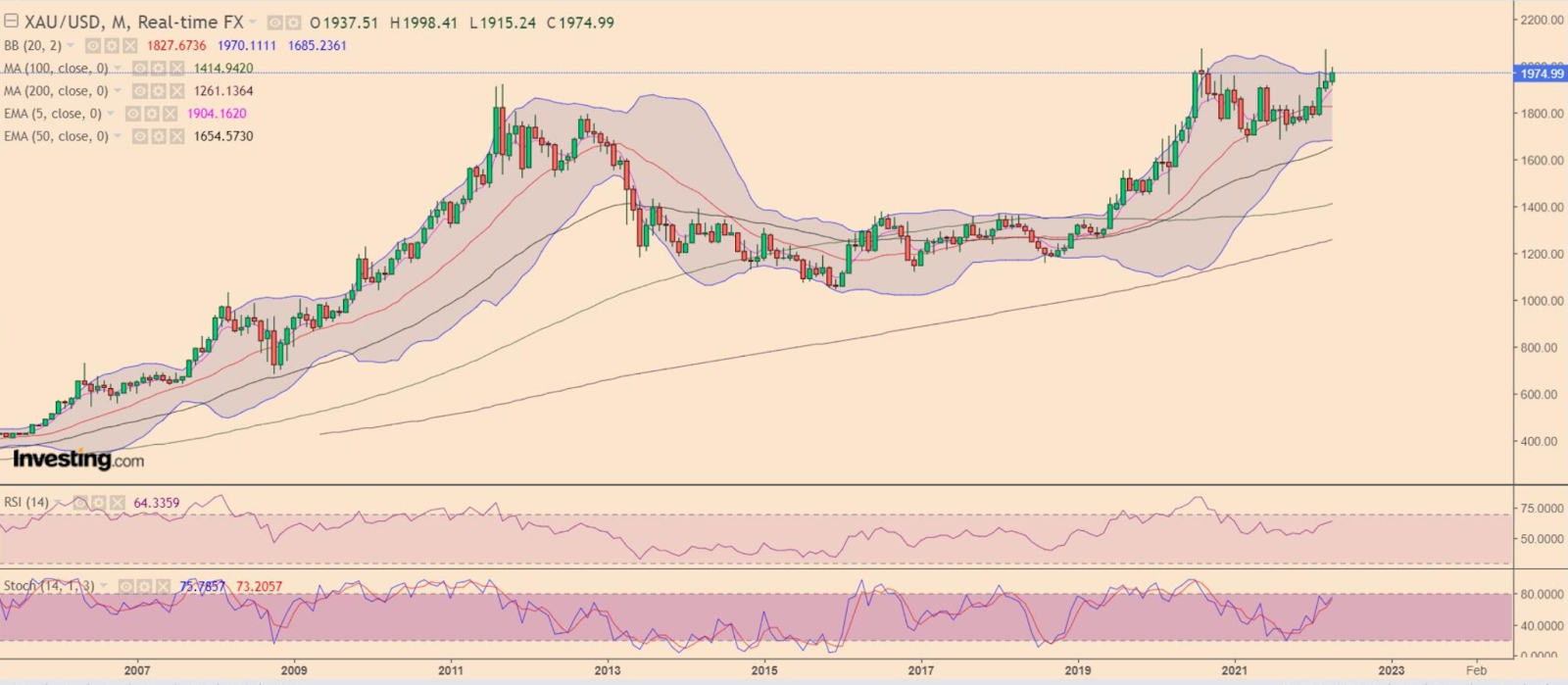In just two weeks, gold bulls have stolen the narrative from the bears in a market that seemed, initially, stacked against them. The reversal has mostly to do with one word: Recession.
Fears that an overly aggressive Federal Reserve could end up choking recovery in its attempts to stamp out inflation has had traders retrenching from both stocks and bonds in the past fortnight.
Add to that geopolitical tensions from the war in Ukraine ratcheting by the day, along with talk of new sanctions against Russia, and suddenly investors who were light on safe-havens were rushing to load up on precious metals and other commodities that might provide protection from one of the greatest market uncertainties in a generation.

All charts courtesy of skcharting.com
The combined effect was gold’s return on Monday to a $2,000 high—its first in six weeks.
Gold’s flight was brief as the front-month June futures contract on New York’s COMEX catapulted more than $25, or 1.3%, to peak at $2,000.55 an ounce, before settling the session at $1,986.40. That was $11.50, or 1.2%, higher from its finish on Thursday, before the Good Friday holiday.
By Tuesday’s session in Asia, June gold seemed to have lost a little more of the previous day’s allure, trading almost $10, or 0.5%, in the deficit at $1,976.70 by 2:00 PM in Singapore (2:00 AM in New York).
Where it stands, gold is about $145, or 7%, from COMEX’s all-time high of $2,121.70 hit in August 2020.
But the spike on Monday was important for several reasons.
It was the first time COMEX gold had traded above $2,000 since Mar. 11, when it burst higher in the fortnight after the Ukraine invasion which elevated risk across markets.
Monday’s rally also came as the yield on the US Treasury’s benchmark 10-year note peaked at 2.884%, a level unseen since December 2018, when it stood at 3.050%. Prior to the war, any spike in US bond yields had been destructive to gold. But 2022 has brought gold immunity to rising yields, with both rising in recent days on inflation/recession concerns.
Since gold hit over $2,000 in March it has also been volatile, tumbling to as low as 1,888.30 on COMEX on Mar. 29.
More interestingly, Monday’s run-up in gold came as the Dollar Index broke above 100 the first time since May 2020—when the greenback initially held up against other currencies in the early days of the COVID-19 outbreak.
Like bond yields, the dollar has typically had an inverse relationship with gold. There was no immediate telling if that negative correlation had snapped as of now, and the two will be joined at the hip in the coming days.
“The inverse dollar-gold relationship is not a given,” said Phillip Streible, precious metals strategist at Blue Line Futures in Chicago. He added:
“What’s more important is how worried investors are about things, and all focus now is whether we will avoid a recession. I think inflation is the bigger factor, over concerns that an aggressive Fed response could tip the US economy into recession.”
James Stanley, a senior strategist for gold who blogs on the Daily FX platform, concurred.
“Gold bulls have staged a comeback over the past two weeks after bears failed to take advantage of a bearish breach below the $1,900 level,” Stanley wrote in a commentary after Monday’s market close. Adding:
“Sellers had their chance and despite a seemingly bearish backdrop for gold with US rates surging, gold bulls have had their way, forcing a topside break of an ascending triangle formation to re-test the psychological level at $2,000/oz.”

What’s evident is that fears over the 'R-word', recession, have been growing by the day as the Fed gets increasingly tough in its inflation talk.
For instance, the central bank’s most hawkish policy-maker, James Bullard, suggested on Monday that US interest rates be raised as much as 75 basis points, or three quarters of a percent, in a month to beat runaway inflation.
“I won't rule out a 75 basis-point increase, but it isn't the base case,” Bullard, who is St. Louis Fed President, said in comments made at a live-streamed event.
After slashing US interest rates to nearly zero at the height of the COVID-19 outbreak, the Fed’s policy-making Federal Open Market Committee (FOMC) approved the first pandemic-era rate hike on Mar. 16, raising rates by 25 basis points, or a quarter point.
Many FOMC members have concluded since that the hike was too tame to rein in inflation galloping at 40-year highs. The central bank is also considering as many as seven rate adjustments in all this year.
Bullard and various Fed officials have pushed for “one to two” 50 basis point raises in the near term to help the central bank get a better grip on fighting price pressures, and expectations are that the FOMC meeting on May 4-5 could see the first of such hikes.
But a 75-basis point increase will break new ground and could galvanize opposition from conservative economists who feel growth will be throttled altogether, landing the country into recession.

The last time the US economy experienced a recession, which is technically defined as two straight quarters of negative growth, was during the height of the COVID-19 outbreak between March and September 2020.
Wall Street's leading bank Goldman Sachs on Monday assessed a 35% probability that the next US recession will occur within two years.
“Bullard comments really encapsulate the quandary that many of the world’s central banks have found themselves in,” said Jeffrey Halley, senior market analyst for Australia and Asia Pacific at online trading platform OANDA.
“Having completely missed the ball around transitory versus embedded inflation, there are no palatable solutions.”
Bullard sought to allay concerns that the Fed’s aggressive fight over inflation will itself cut the legs off the economy. “There will be no recession” he declared, adding:
“Inflation is far too high for comfort, the Fed has a good plan in place.”
After contracting 3.5% in 2020 from disruptions forced by COVID-19, the US economy expanded by 5.7% in 2021, growing at its fastest pace since 1982.
But inflation grew even faster. The Personal Consumption Expenditure Index, a US inflation indicator closely followed by the Fed, expanded 5.8% in the year December and 6.4% in the 12 months to February, both also at their fastest in four decades.
FOMC officials have vowed to bring inflation back to the Fed’s target range of 2% a year anywhere from between the end of 2022 and the end of 2023.
Bullard said the Fed was so far behind in its fight against inflation that it needs to raise rates another 3 percentage points before the year's end.
So, where does gold stand technically in the race toward new $2,000 highs?
“As long as gold sustains above 1,988, further gains are coming to take the metal to $2,005-$2,025,” said Sunil Kumar Dixit, chief technical strategist at skcharting.com, who models his projections on the spot price of gold. He added:
“Even at the lower level, if bulls manage to stay above $1,973, then gold is likely to resume its upward move, to $1,988 first, and eventually attempt to regain $2,000 before climbing past $2,010.”
But traders must be particularly cautious about Monday’s $1,971 low, “below which sellers will take control,” Dixit warned.
“A break below $1,958 will trigger unwinding of weak longs among retail and margin traders, leading to a correction of $1,932.”
Disclaimer: Barani Krishnan uses a range of views outside his own to bring diversity to his analysis of any market. For neutrality, he sometimes presents contrarian views and market variables. He does not hold positions in the commodities and securities he writes about.
